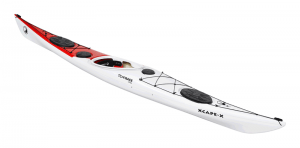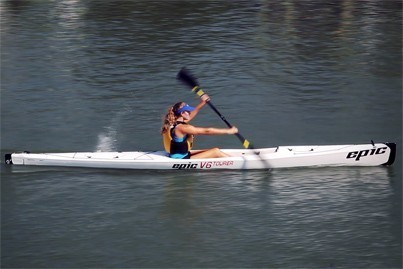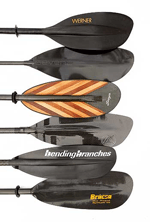 When buying a kayak it is important for you to have a clear idea of what you want to do with it. Do you wan the kayak be fast, stable, course-proof, light, etc.
When buying a kayak it is important for you to have a clear idea of what you want to do with it. Do you wan the kayak be fast, stable, course-proof, light, etc.
Image: Tiderace Extreme sea kayak
If you are planning to also make camping trips with the kayak then a kayak with watertight compartments in the front and rear deck with large deck hatches is recommended so that you can take the camping equipment along with no problems. Never buy a kayak without first taking it out and testing it. It is often possible to try out various kayaks at clubs and shops first.
- Types
- Materials
- Paddles
Types
Recreational kayak
These are short (up to 4 meters) and wide kayaks (usually between 70 and 75 cm wide), so very stable and agile but not so fast, suitable for short trips on flat water.
Tour kayak
Slightly less wide (around 60 cm) and longer than the recreational kayak, often with a watertight compartment and deck lines, suitable for long trips on inland water.
Sea kayak
These have a length of up to 5.5 meters and are up to 60 cm wide, and feature a characteristic ascending front and rear point, they are often fast and equipped with 2 or 3 watertight compartments and cover lines along the entire length of the kayak, suitable for long trips on large water and within water.
sit-in and sit-on top kayaks
With a sit-in kayak, you are in the kayak, these are suitable for all seasons as there is enough shelter to keep the water out of the boat. They are often equipped with compartments.
Sit-in kayak Epic 18 X kayak
The sit-on top kayaks where you sit on the kayak ( an example is the surf ski), the advantage is the great freedom of movement and when you turn up you can easily climb on the kayak again, the downside may be that you are less sheltered in cold weather conditions.
Sit-on-top kayak Epic V6 TOURER
Paddels
The purchase of the paddle is just as important as the purchase of the kayak, because with the paddle the kayak is moved forward. For kayaking, you use a double-bladed paddle with the paddle blades turned (the paddle blade which is not in the water thus reduces the wind)
The paddle blade is often asymmetrical in shape, the top of the blade has a different shape than the bottom of the leaf, so the water pressure on the leaf remains the same during the insertion into the water.
There are different lengths available, to determine the correct length a much-used method is to check whether it is possible to lock your fingertips over the paddle blade with a vertically held paddle, but this is not always sufficient, so be sure to get some good advise.
Material
Kayaks are usually made of polyester; form-retaining and light but vulnerable, or made of polyethene, these are durable but heavy and less dimensionally stable. They are also made of ABS thermoform / Prilite, which are strong, UV-resistant and lighter in weight. In addition, there are kayaks of kevlar/carbon (strong and light). You also have the inflatable kayaks, these are easy to carry, sailing characteristics are less than hard-shell kayaks. Folding kayaks (usually wooden or metal construction with skin) do take some time to build up.




